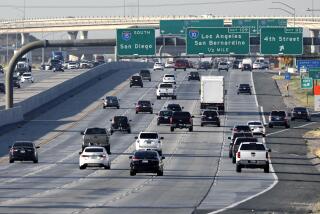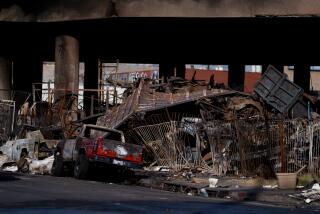‘It Was Chaos,’ but Caltrans Was Prepared : Travel: Agency had positioned road-clearing equipment in strategic spots and had hundreds of workers on call as it hunkered down to take the storm’s worst punch.
Days before Saturday’s storm hit Southern California, strategists at the state’s Department of Transportation began making preparations.
They positioned road-clearing equipment in trouble spots and made ready to call up hundreds of workers.
In Caltrans’ local Traffic Management Center in Downtown Los Angeles--a room filled with computers, traffic monitors and elaborate road maps--everyone knew the storm was coming. No one knew, however, where on the 500 miles of major highways in Los Angeles and Ventura counties it was going to inflict its worst devastation.
They began to find out between 8 and 10 Friday night. Mudslides in Malibu closed Pacific Coast Highway. A broken pump forced the closure of part of the I-5 Freeway. Flooding shut down the Harbor and Santa Monica freeways, as well as several other roadways in Los Angeles and Ventura counties.
“It was chaos,” said Ray Higa, a Caltrans traffic engineer who works in the electronic nerve center. “Fortunately we have experienced people both in the field and in the Traffic Management Center.”
By midday Saturday, half a dozen workers at the center were busy coordinating the more than 1,000 maintenance workers in Los Angeles and Ventura counties who were on call for the storm.
Inside the traffic management room, workers dispatched repair crews and coordinated activities with the California Highway Patrol.
Earlier this week, Caltrans had prepared for the storm by transporting bulldozers, trucks and other earthmoving vehicles to strategic locations, where they could be used by repair crews to clean up debris, unclog drains and clear roadways closed by mudslides.
“It’s been a rough month. In fact, it’s been a hectic year,” said James J. McCarthy, a Caltrans executive on weekend duty in the management center, his 2-year-old in tow. He said that the Northridge earthquake, combined with earlier storms, have stretched crews to their limits.
CHP spokesman Rob Lund, who also works in the Traffic Management Center, said the storm contributed to more than 400 highway accidents in Los Angeles County between 8 p.m. Friday and 8 a.m. Saturday. That total compared with fewer than 100 accidents during a similar 12-hour period last week.
“People are just not being cautious enough,” Lund said. “They drive too fast and they don’t look far enough ahead.”
In one accident, a man died when his car skidded off the Pasadena Freeway and plunged 25 feet into the Arroyo Seco channel near Pasadena Avenue.
During the height of the storm, transportation engineers were not only directing repair crews, but also managing traffic around a flurry of jackknifed trucks, overturned vehicles and mudslides.
“Our management team has been floating from one incident to another,” said Scott Mohler, a transportation engineer. “But in a way we are very lucky this happened on a weekend. Now we have some time, I hope, to get things running smoothly again.”
Caltrans spokesman Jim Drago said that problems caused by the storm have been more severe in areas outside Los Angeles. “In Los Angeles and areas south, the problems haven’t been quite as bad as other parts of the state.”
But the full extent of the damage from the weekend storms will not be determined until the rains stop, he said.
“That’s when we will test to see whether there is any structural damage to roadways and bridges.”
More to Read
Sign up for Essential California
The most important California stories and recommendations in your inbox every morning.
You may occasionally receive promotional content from the Los Angeles Times.










